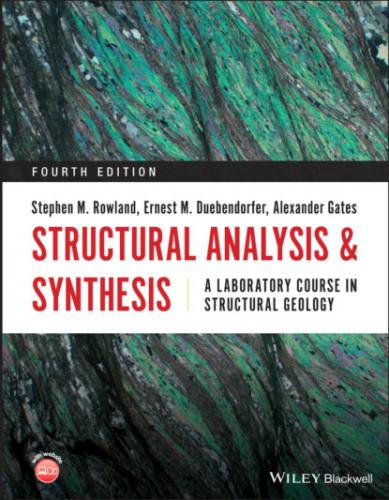Read back the structural elements on the map in Figure P1.2 and determine what the symbol represents. Fill in the table below with the results.
| Location | Strike/trend | Dip/plunge | Element |
| a | |||
| b | |||
| c | |||
| d | |||
| e |
Figure 1.6 Topographic map showing linear ridges and the line to measure structural grain of a ridge.
Karst topography is common in temperate areas underlain by limestone. One of the main features of karst is the formation of sinkholes. In many cases, the location of sinkholes is controlled by joints, joint systems/fracture trends, and brittle faults. In particular, sinkholes are common at the intersection of joints or faults. Aligned sinkholes can define zones of joints (fracture zones). By measuring the bearing of aligned sinkholes, the alignment of such brittle features may be determined.
In some cases, an indication of dip can also be determined from the topography. If the more resistant units that make up the ridges are shallowly dipping, there will typically be a dip slope and a strike or scarp slope. The steeper side of the ridge results from erosion of the unit face and is the strike slope. The shallower side of the ridge generally follows the dip of the bed. The dip direction is in the direction of the shallow side and the strike approximately follows the structural grain of a ridged area.
Using the map in Figure P1.3, determine the structural grain of the areas indicated. Also, determine the dip direction where possible.
| Location | Structural grain | Dip direction? |
| a | ||
| b | ||
| c | ||
| d | ||
| e |
Figure P1.1 Base map on which to plot structural symbols in Problem 1.4.
Figure P1.2 Map with structural symbols to be read back in Problem 1.5.
Figure P1.3 Topographic map showing linear ridges with uneven slopes to measure structural grain and possible dip direction in Problem 1.6.
2 Outcrop Patterns and Structure Contours
Objectives
Determine the general attitudes of planes from outcrop patterns.
Draw structure‐contour maps.
Solve three‐point problems.
Determine outcrop patterns of planar layers from attitudes at isolated outcrops.
Determine the nature of contacts from outcrop patterns and attitudes.
Determine stratigraphic thickness from outcrop pattern.
One of the primary roles of a geologist is to quantitatively determine subsurface structural relations from surface and/or well data. Your skills to address this will be developed starting with planar features and progressing to more complex structures. Planar structural elements such as contacts between monoclinal beds, dikes, and faults form irregular outcrop patterns on the uneven earth's surface. In situations where strike and dip symbols are not provided (such as on regional, small‐scale maps), outcrop patterns can serve as clues to the orientations of the planes. These relations should also be used for constructing maps from field data. The following are seven generalized cases showing the relationships between topography and the outcrop patterns of planes as seen on a map. As you examine Figures 2.1–2.7, cover the block diagram (parts a) and try to visualize the orientation of the bed from its outcrop pattern in map view (parts b). Note the strike and dip symbols that indicate orientation.
1 Horizontal planes/contacts parallel topographic contour lines. They also “V” or point upstream but this is not unique (Figure 2.1).
2 Vertical planes/contacts are not deflected at all by valleys or ridges (Figure 2.2).
3 Moderate to steeply inclined planes “V”/point opposite to the direction of dip across horizontal or shallowly inclined ridges (Figure 2.3).
4 Planes/contacts
